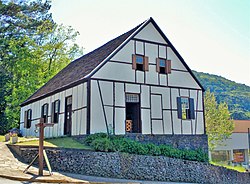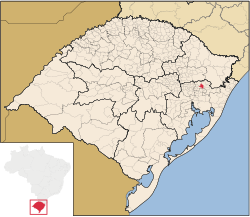Hunsrik, also called Riograndenser Hunsrückisch or Katharinensisch, is a Moselle Franconian language derived primarily from the Hunsrückisch dialect of West Central German which is spoken in parts of South America. A co-official language in the Brazilian municipalities of Antônio Carlos, Santa Maria do Herval, and São João do Oeste, Hunsrik is spoken in the states of Rio Grande do Sul, Santa Catarina, and Paraná, as well as some regions of neighboring Paraguay and Argentina. It has been an integral part of the historical and cultural heritage of the Brazilian state of Rio Grande do Sul since 2012, and considered an intangible cultural heritage of Santa Catarina state since 2016.
The (Low)German-based varieties spoken by German Brazilians together form a significant minority language in Brazil. "Brazilian German" is strongly influenced by Portuguese and to a lesser extent by Italian dialects as well as indigenous languages. High German and Low Saxon/German dialects and Germanic languages are particularly strong in Brazil's South and Southeast Regions. According to Ethnologue, ca. 3 million people in Brazil speak the Hunsrik Language, 1.5 million speak Standard German.

Santa Maria is a municipality (município) in the central region of Rio Grande do Sul, the southernmost state of Brazil. In 2020, its population was 283,677 inhabitants in a total area of 1,823 square kilometres (704 sq mi). Santa Maria is the 5th biggest municipality in the state, and the largest in its micro-region.

The Federal University of Santa Maria is a Brazilian public university located in Santa Maria, in the state of Rio Grande do Sul, funded by the federal government of Brazil. It was founded in 1960, by Professor José Mariano da Rocha Filho. Its campuses span over 1,837.72 ha, with a total of 386,968 m² of buildings and 28,307 students.

The Rota Romântica is a scenic tourist route that runs through 13 municipalities located in the Serra Gaúcha region of the southernmost Brazilian state of Rio Grande do Sul. The area was first colonized by German immigrants in the first half of the 19th century, and the strong German influence can still be seen in each of the towns and villages. The Germanic roots are visible in the architecture, gastronomy and occasionally in the accent and language of the region.
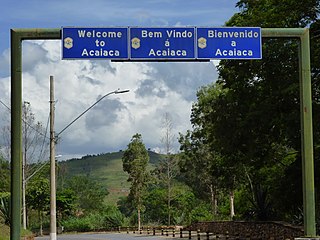
Portuguese is the official and national language of Brazil being widely spoken by most of the population. Brazil is the most populous Portuguese-speaking country in the world, with its lands comprising the majority of Portugal’s former colonial holdings in the Americas.

Herval is a Brazilian municipality in the southern part of the state of Rio Grande do Sul. The population is 6,814 in an area of 1757.84 km². Its elevation is 287 m. Its main industry is agriculture.

Arroio Grande is a Brazilian municipality in the southern part of the state of Rio Grande do Sul. The population is 18,238 in an area of 2513.60 km². Its second industry is agriculture which was primary until the 1970s, it currently has more urban population (80%) than rural (20%). Much of the area is made up of plains.

Pedro Osório is a Brazilian municipality in the southeastern part of the state of Rio Grande do Sul. The population is 7,706 in an area of 608.79 km². The municipality was founded on April 3, 1958 from parts of the municipalities of Canguçú and Arroio Grande. Cerrito was separated in 1997.

The Jaguarão microregion is a microregion in the southern part of the state of Rio Grande do Sul, Brazil. Its total area is 6,331.228 km².

The Centro Ocidental Rio-Grandense is one of the seven mesoregions of the state of Rio Grande do Sul in Brazil. It consists of 31 municipalities, grouped in three microregions:
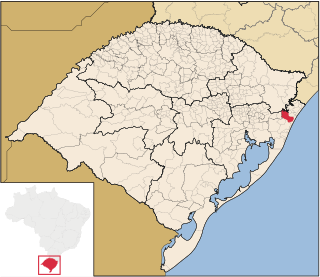
Maquiné is a municipality in the state of Rio Grande do Sul, Brazil.
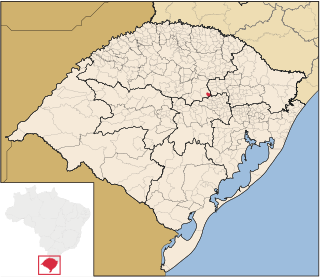
São José do Herval is a municipality in the state of Rio Grande do Sul, Brazil, commonly known as Dead Donkey by the inhabitants of the region. As of 2020, the estimated population was 1,943.
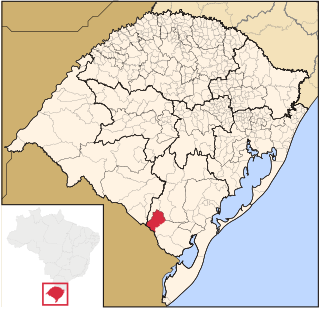
Pedras Altas is a Brazilian municipality in the southern part of the state of Rio Grande do Sul. The population is 1,954 in an area of 1377.37 km2. The Jaguarão River, which forms the border with Uruguay here, flows along the southwestern part of the municipality.

Manuel Luís Osório, Marquis of Erval was a Brazilian military officer, monarchist and politician. A member of the Imperial Army at the age of fifteen, he climbed all the posts of the military hierarchy of his time thanks to the soldier attributes that consecrated him as "The Legendary". He participated in the main military events of the late nineteenth century in the Río de la Plata region and is considered a hero of the Paraguayan War. He was declared patron of the Cavalry Branch of the Brazilian Army in 1962.

Boca do Monte is a district of the municipality of Santa Maria, in the Brazilian state of Rio Grande do Sul. It is situated in the northwest portion of Santa Maria. The district's seat is located 16 km from Downtown Santa Maria.

Arroio Grande is a bairro in the District of Arroio Grande in the municipality of Santa Maria, in the Brazilian state of Rio Grande do Sul. It is situated in northeast of Santa Maria.

BR-392 is a federal highway in Rio Grande do Sul. The highway begins at the port town of Rio Grande in the south and runs north across the state, connecting the municipalities of Pelotas, Santa Maria, Santo Ângelo, and ending in Porto Xavier at the border with Argentina.
Vila Maria is a municipality in the state of Rio Grande do Sul in the Southern Region of Brazil.

In Brazil, the lords of Casa da Torre de Garcia d'Avila pioneered the livestock industry, often using indigenous labor as cowboys. However, a great drought in the Northeast and the discovery of precious minerals in Minas Gerais at the end of the 18th century moved the cattle ranch in Brazil to the Southeast and South, more specifically São Paulo and Rio Grande do Sul.
